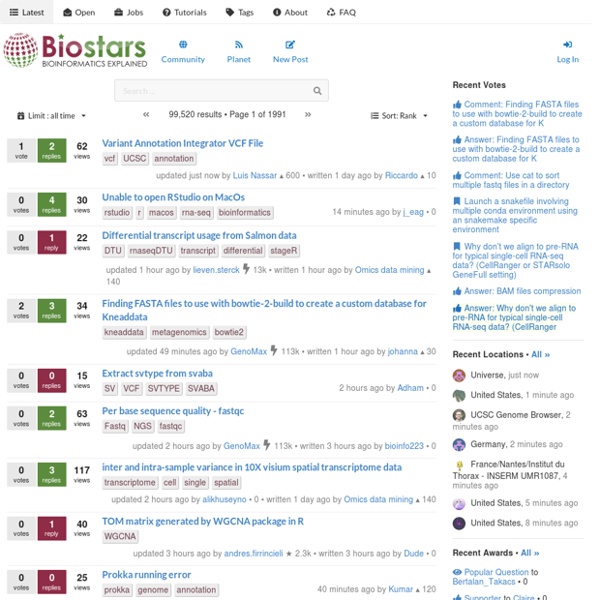



Canadian Bioinformatics Workshops | Bioinformatics.ca - Canadian Bioinformatics Workshops (CBW) R Reference Card Interpretome Load your genome file (upper-right corner) and choose some of the analyses above. Currently, only raw data files from 23andme and Lumigenix (unzipped) are supported. Sample genotype files (and a description of the individuals) can be found here. A detailed description of the website design and some of the modules can be found in our PSB paper as well as in blog posts here and here. Interpretome is intended for educational and research purposes only. No information should be considered diagnostic and as with any genetic testing service, the interpretation is not regulated by the FDA. How are my data kept private? Your genome will not be sent to any server, it remains on your computer. Your browser is NOT compatible with the Interpretome! Compatibility This website requires an HTML5 compatible browser, including current versions of: Google Chrome (≥ 6.0), the preferred browser Mozilla Firefox (≥ 4.0) Safari (≥ 6.0) RockMelt Citation Happy Exploring! -The interpreteam (About us)
Circos - Tutorials The tutorials serve as a walkthrough through Circos. The course is a more structured set of materials that takes you through creating an image from scratch. The tutorials act as documentation — each lesson presents a specific feature of Circos. Example Image Once you download and install Circos, > tar xvfz circos-x.xx.tgz > cd circos-x.xx try creating the example image that ships with the Circos core distribution. > cd example > . Creating a Tutorial Image You will need to download the tutorials separately. > cd tutorials/2/2 > ../../.. In each tutorial directory (e.g. tutorials/2/2), there will be several configuration files (*.conf). Creating Your Own Image The first thing you will need is the karyotype for your genome. You can download the karyotype from the table browser or directly for human hg19 (Feb 2009)hg18 (Mar 2006), mouse mm9 (Jul 2009)mm8 (Mar 2006), rat rn4 (Nov 2004)rn3 (Jun 2003), or other species.
Regex Tutorial—From Regex 101 to Advanced Regex BB 350 Oregon State University Schedule for BB 350 Ecampus (Note - this is the page for the ECAMPUS version of BB 350. The CLASSROOM version is different and should not be used by CLASSROOM students, nor should the ECAMPUS version be used by CLASSROOM students) The syllabus is required reading in this course. Technical Notes - You should use the YouTube videos for viewing and the iTunes U videos for downloading. You connect with iTunes U for OSU HERE. There are many songs sung on the lecture videos. This page has been replaced by a more recent version.
Learning R BioSharing Papers - 1.9.4 [Intel] Papers 1.9.4 [Intel] | MacOS | 34.60 MB Papers · your personal library of research: Repository of knowledge, Search article repositories and download articles without leaving Papers, All your papers at a glance, Papers lets you view, browse and search your library, iTunes style. Smart groups. Collect your articles together or create smart groups that are always up to date. Features: * Import: Simply drag and drop your PDFs to import them into Papers, or import from Endnote or a BibTeX file. * Searching: Search through the world's largest article repositories direct from within Papers. * Collections: Organize your library by topic, project or anything else, with help of manual and smart collections Link for more information: DownloadHotfileFileServe
bedtools: a powerful toolset for genome arithmetic — bedtools 2.30.0 documentation Collectively, the bedtools utilities are a swiss-army knife of tools for a wide-range of genomics analysis tasks. The most widely-used tools enable genome arithmetic: that is, set theory on the genome. For example, bedtools allows one to intersect, merge, count, complement, and shuffle genomic intervals from multiple files in widely-used genomic file formats such as BAM, BED, GFF/GTF, VCF. While each individual tool is designed to do a relatively simple task (e.g., intersect two interval files), quite sophisticated analyses can be conducted by combining multiple bedtools operations on the UNIX command line. bedtools is developed in the Quinlan laboratory at the University of Utah and benefits from fantastic contributions made by scientists worldwide. We have developed a fairly comprehensive tutorial that demonstrates both the basics, as well as some more advanced examples of how bedtools can help you in your research. Commands used:
.NET Bio Summer 2010 — R: ggplot2 Intro Contents Intro When it comes to producing graphics in R, there are basically three options for your average user. base graphics I've written up a pretty comprehensive description for use of base graphics here, and don't intend to extend beyond that. Both and make creating plots of multivariate data easier. The website for ggplot2 is here: Basics is meant to be an implementation of the Grammar of Graphics, hence gg-plot. Plots convey information through various aspects of their aesthetics. x position y position size of elements shape of elements color of elements The elements in a plot are geometric shapes, like points lines line segments bars text Some of these geometries have their own particular aesthetics. points point shape point size lines line type line weight bars y minimum y maximum fill color outline color text label value The values represented in the plot are the product of various statistics. Layer by Layer Displaying Statistics
Welcome | bioontology.org